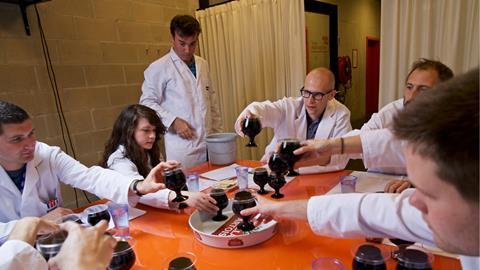Researchers in Leuven have managed to objectively improve Belgian beers by using artificial intelligence to analyse more than two hundred chemical components, according to Nature Communications.
It takes courage to tinker with Belgian beer. Belgian beer culture is a UNESCO World Heritage Site and Belgian brewers are proud of their products. But a team from VIB-KU Leuven has embarked on a major project to determine, in a scientific, chemical way, what could make beer better.
‘We definitely noticed some reluctance at Belgian brewers’ conferences when we talked about our project’, says head researcher Kevin Verstrepen, professor at KU Leuven and director of the VIB-KU Leuven Centre for Microbiology. Comments such as “our beers are already good”, “we don’t want AI-generated uniformity” or “we want to brew, it’s a craft!” were all too common. But it was never our goal to define what the perfect beer should be.’
Predicting appreciation
Instead, the researchers looked for a way to predict both the taste and appreciation of different beers. To do this, they analysed the chemistry and taste perception of 250 different beers, using a professional tasting panel and a mountain of data from a beer forum (RateBeer). They used the more than 180,000 ratings to train different algorithms to predict complex aromas and flavours.
The results were sometimes quite surprising. ‘Complexity is very important’, says Verstrepen. ‘There are no one or two components that make the best flavour.’ Out of more than 200 molecular compounds, fruity esters and terpenoids made the biggest contribution, adds first author Michiel Schreurs, a PhD student in Verstrepen’s group. ‘We mainly looked at how the different aroma molecules correlated with each other. In particular, there was less information available on hoppy aromas in Belgian beers, because Belgian beers contain less hops than in other countries.’
Article continues below the image

Cauliflower aroma
It was also striking that so-called off-flavours, odours and tastes that brewers try to keep out of beer at all costs, actually had a positive influence on flavour. Verstrepen: ‘Think of diacetyl or dimethyl sulphide, which give a slightly musty butter or cauliflower smell respectively. But certain off-flavours have been found to improve the beer. Provided, of course, that you don’t add too much of them.’
A good example is the relationship between isoamyl acetate and ethyl acetate. ‘Isoamyl acetate is one of the main flavouring components; it gives a subtle banana or pineapple flavour’, Verstrepen explains. ‘But it turned out that ethyl acetate, which is usually suppressed, was at least as important.’
Schreurs: ‘The effects of the different components are highly concentration-dependent. Separately, the off-flavour molecules are negative anyway, but in combination with other substances their contribution becomes positive. The message is therefore: beer improvement is not usually achieved by adding just one component, which quickly makes the whole thing artificial. It’s the combination that counts.’
Alcohol-free beer
The researchers have a twofold objective with the study, says Verstrepen. ‘We see a big opportunity for the development of non-alcoholic beers, there is considerable scope to make beers fresher and tastier, to still get the alcoholic flavour without alcohol. You can also extend this to food in general. AI is making an appearance in the food industry and our study is a good example of how it can contribute to this field. In addition to improving flavour, you can also think of quality control as an application of this research.’
The work was not just theoretical: ‘We actually improved two commercial beers, one non-alcoholic and one alcoholic’, says Verstrepen. ‘Our scientific tasting panel indicated that the taste had improved.’ In addition, the researchers have since partnered with spin-off Bar.on, a small company that does not use traditional beer brewing methods, but uses their results to produce beer-like drinks.
Schreurs adds: ‘We really couldn’t have done this without machine learning. We needed the computer to find these complex patterns. It also allows us to really predict specific flavours, so we can predict what people taste based on chemistry.’ In addition, Schreurs and Verstrepen stress that they are only providing the information for improvement. ‘The model makes connections, but we cannot make the best beer for everyone. So Belgian brewers will certainly not be put out of work.’
Schreurs, M., Piampongsant, S., Roncoroni, M. et al. (2024) Nat. Commun. 15, DOI: 10.1038/s41467-024-46346-0













1 Opmerking van een lezer